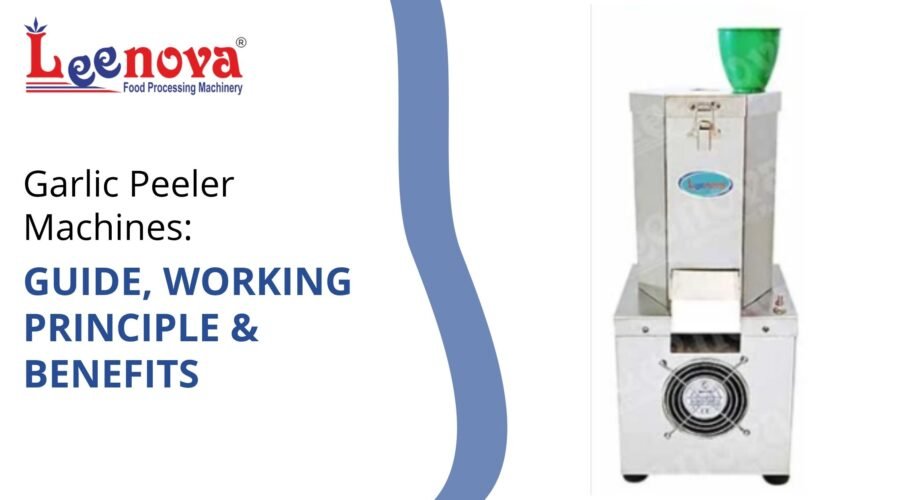Manual garlic peeling costs restaurants ₹16-18 per kilogram in labor, plus 1.5-2 hours of prep time daily. A commercial kitchen peeling 20 kg of garlic daily spends 30-40 hours monthly on this single task. A garlic peeler machine eliminates that waste. Research shows automated peeling saves 97% of manual labor time and reduces processing costs by 95%. As a food processing equipment manufacturer since 2006, we design garlic peelers that process 10-12 kg per hour while maintaining 86-99% peeling efficiency with minimal clove damage. This guide explains how garlic peeler machines work, the types available, capacity considerations, operational benefits, and what features matter when selecting equipment for commercial kitchens.
How Garlic Peeler Machines Work
Dry Type Pneumatic Peeling
Dry type garlic peelers use compressed air to separate skin from cloves. Garlic enters through a feed hopper into a cylindrical chamber. High-pressure air at 5-9 bar creates a cyclone vortex inside the chamber.
The air pressure and rotational force rub cloves against each other and the chamber walls. Friction removes the papery skin without water or chemicals. The peeling cycle runs 10-20 seconds per batch depending on garlic freshness and skin tightness.
A separation mechanism sorts peeled cloves from skin debris. Peeled garlic exits through one outlet while lightweight skin gets blown out through another. The entire process maintains clove integrity with damage rates under 5%.
Mechanical Roller Systems
Mechanical peelers use rotating rubber rollers or cylinders with textured surfaces. Garlic cloves pass between counter-rotating rollers that grip and pull the skin away through shearing action.
The cylinder-concave clearance determines peeling efficiency. A 10 mm gap provides optimal balance between thorough peeling and minimal clove damage. Cylinder speed around 36 RPM delivers consistent results across different garlic varieties.
Types and Capacity Selection
Small Commercial Units (10-15 kg/hr)
Entry-level garlic peelers process 10-15 kg per hour, suitable for restaurants, cloud kitchens, and small catering operations. These units weigh 10-14 kg, operate on single-phase 220V power, and fit on standard kitchen countertops.
The compact design measures approximately 200-250 mm in length and width. Single-phase motors consume minimal electricity while delivering 1440 RPM processing speed. Pricing ranges ₹12,500-18,000 depending on construction material and automation level.
Medium Capacity Models (30-100 kg/hr)
Mid-range machines handle 30-100 kg per hour for hotels, large restaurants, and food processing units preparing bulk quantities. These semi-automatic or fully automatic models feature larger chambers and more powerful motors.
Three-phase 440V motors provide the power needed for continuous operation during peak prep hours. Construction typically uses food-grade stainless steel for durability and hygiene compliance.
Industrial Scale Equipment (200+ kg/hr)
High-capacity peelers process 200-950 kg per hour for garlic suppliers, packaging facilities, and industrial food manufacturers. These fully automated systems include integrated feeding mechanisms, separation units, and collection systems.
Key Benefits for Commercial Operations
Labor Cost Reduction
Manual garlic peeling costs ₹16.11 per kilogram in labor alone. A machine reduces this to ₹1-2 per kg including electricity and maintenance. Processing 500 kg monthly saves ₹7,000-8,000 in direct labor costs.
The time savings amplify in large operations. What takes one person 1.63 hours manually happens in 3 minutes with a machine. That freed labor capacity redirects to higher-value kitchen tasks like cooking, plating, and quality control.
Peeling Efficiency and Quality
Modern garlic peelers achieve 86-99% peeling efficiency depending on settings and garlic condition. Fresh garlic with tight skin peels more effectively than aged garlic with loose, dry skin.
Clove damage rates stay below 5% with properly adjusted machines. Manual peeling often damages 8-12% of cloves through crushing, cutting, or bruising. Intact cloves maintain better shelf life and appearance in finished dishes.
Hygiene Standards
Automated peeling eliminates direct hand contact with garlic. This reduces bacterial transfer and contamination risks, critical for food safety compliance. Stainless steel construction allows thorough cleaning and sanitization between batches.
The dry peeling process avoids water usage, preventing moisture-related spoilage issues. Peeled garlic stays dry and ready for immediate use or refrigerated storage.
Material and Construction Features
Stainless Steel vs Alternative Materials
Food-grade stainless steel (SS 202 or SS 304) provides corrosion resistance and meets commercial kitchen hygiene standards. SS 202 grade offers good durability at lower cost, while SS 304 delivers superior corrosion resistance for heavy-duty applications.
The chamber, rollers, and contact surfaces require stainless steel to prevent rust contamination. Frames and support structures may use mild steel with protective coating to reduce costs without compromising food safety.
Automation and Controls
Semi-automatic machines require manual feeding and monitoring. An operator loads garlic batches, starts the cycle, and collects peeled output. This suits operations with varying batch sizes and multiple prep tasks.
Fully automatic models feature continuous feed systems with sensors that regulate flow and prevent overloading. These work best for dedicated peeling operations processing large volumes consistently.
Operational Considerations
Garlic Preparation
Pre-separate garlic into individual cloves before feeding into the peeler. Whole bulbs jam the mechanism and reduce efficiency. Remove any damaged or rotten cloves that might contaminate the batch.
Dry garlic performs better than wet garlic in pneumatic peelers. If garlic has surface moisture, air-dry for 30-60 minutes before processing. This improves skin separation and prevents clogging.
Maintenance Requirements
Clean the peeling chamber after every 3-4 batches to prevent skin buildup that reduces efficiency. Compressed air systems need daily moisture trap draining to maintain air pressure and prevent rust.
Check rubber rollers or cylinder surfaces monthly for wear. Smooth surfaces lose gripping ability and reduce peeling effectiveness. Replace worn components before peeling quality drops.
Lubricate motor bearings per manufacturer schedule, typically monthly for daily-use equipment. Proper lubrication extends motor life from 3-5 years to 8-10 years.
Capacity Matching and ROI
Calculating Daily Requirements
Track actual garlic usage over 2-3 weeks to determine accurate capacity needs. A restaurant using 15-20 kg daily needs at least a 10-12 kg/hr machine to complete peeling in 1.5-2 hours including setup and cleaning.
Overbuying capacity wastes money. A 100 kg/hr machine costs 5-8 times more than a 10 kg/hr unit but provides no benefit to operations processing 20 kg daily.
Payback Period
A ₹13,500 garlic peeler processing 20 kg daily saves approximately ₹320 per day in labor costs (₹16/kg × 20 kg). The machine pays for itself in 42 working days, or roughly 2 months of normal operation.
Higher capacity units show faster payback in volume operations. A ₹38,000 machine saving ₹800 daily reaches break-even in 48 days.
FAQs
What is the typical damage rate for garlic peeler machines?
Quality garlic peelers damage less than 5% of cloves when properly adjusted. Optimal cylinder-concave clearance and appropriate air pressure minimize crushing and bruising. Manual peeling typically damages 8-12% of cloves through inconsistent handling.
Can garlic peelers handle different garlic varieties and sizes?
Yes, most commercial peelers adjust for various garlic types. Larger cloves from varieties like elephant garlic may require slightly different pressure or speed settings. Fresh garlic with tight skin peels more efficiently than aged garlic with loose, dry skin.
How much electricity does a garlic peeler consume?
Small 10-12 kg/hr machines consume approximately 0.3-0.5 kWh per hour of operation. At commercial electricity rates of ₹8-10 per unit, operating cost is ₹3-5 per hour. Larger industrial models consume 1.15 kWh per hour.
What maintenance frequency do garlic peelers require?
Daily cleaning of the peeling chamber and moisture trap drainage. Weekly inspection of skin collection system. Monthly bearing lubrication and roller/cylinder surface checks. Annual motor servicing and electrical component inspection.
Is stainless steel construction necessary for all components?
Food-contact surfaces require stainless steel for hygiene and corrosion resistance. This includes the peeling chamber, rollers, and discharge chutes. Frame and motor housing can use coated mild steel to reduce costs while maintaining food safety compliance.
Conclusion
Garlic peeler machines cut processing time by 97% and reduce costs by 95% compared to manual peeling. The right capacity match, construction quality, and maintenance routine determine long-term value and return on investment.
Leenova Kitchen Equipments manufactures automatic garlic peelers with 10-12 kg/hour capacity, perfect for commercial kitchens and food processing operations. Our machines feature food-grade stainless steel construction (Grade 202), single-phase 220V operation, and 1440 RPM processing speed for efficient, consistent peeling.
Since 2006, we’ve supplied food processing equipment designed for daily commercial use. Our garlic peeler combines automatic operation with compact 25×24×12 inch dimensions and 14 kg weight for easy placement in any kitchen layout.
Ready to eliminate manual garlic peeling from your kitchen workflow? Contact Leenova Kitchen Equipments today for specifications, pricing, and delivery information on garlic peelers built for commercial reliability.


